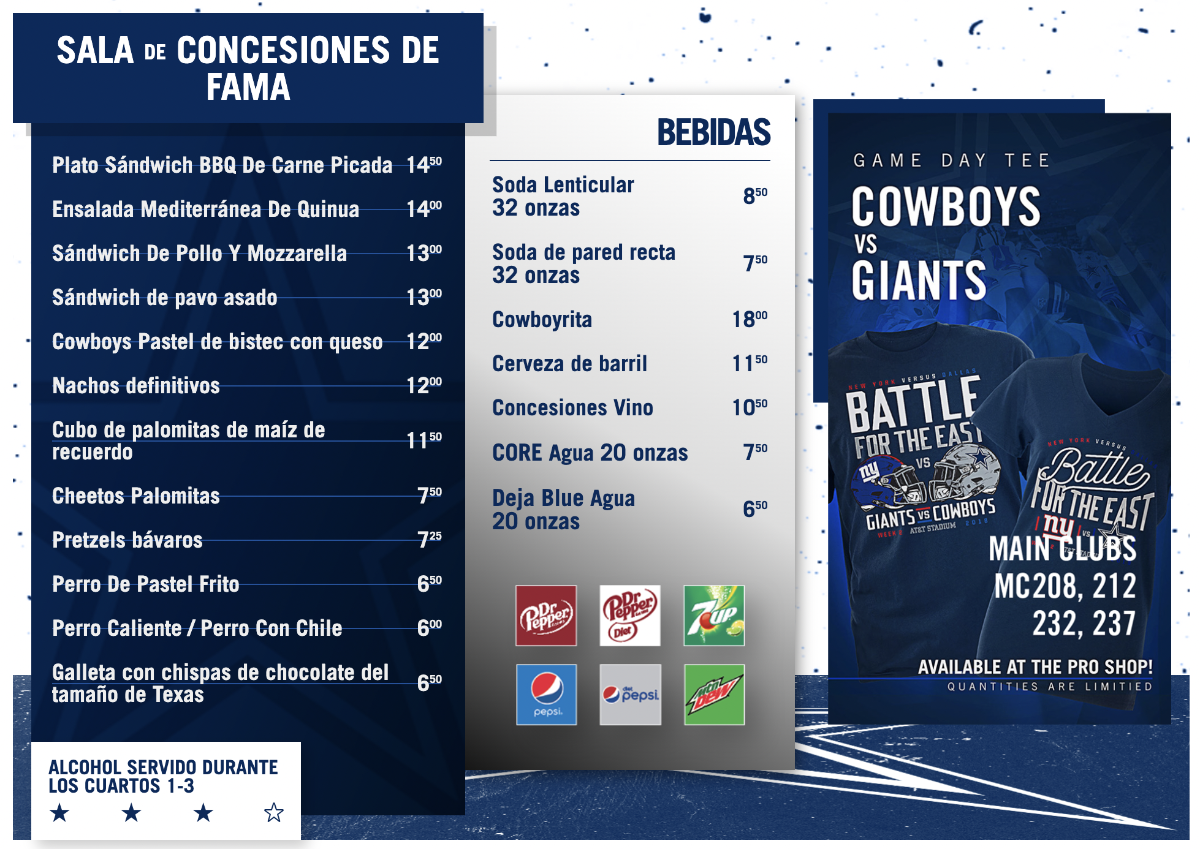Menu Mastery: Unveiling American Ordering Habits and the Influence of Digital Signage
Survey Reveals Americans' Undying Devotion to Beloved Quick-Service Joints and Go-To Menu Delights
American society is notoriously fast-paced. The hustle and bustle of everyday life presents a multitude of options, choices, and possible outcomes that can leave people feeling overwhelmed and depleted. But, one area where Americans like to enjoy uncomplex choices is in the foods we eat and how we obtain them. Many of us rely on Quick-Service Restaurants (QSRs) as a go-to option for meals, drawn to the predictability of the menu, consistent taste and speed of service. The convenience of drive-thrus, online ordering and mobile apps further enhances this comfort, providing a seamless experience that aligns with modern lifestyles.
The team at Creative Realities was curious to learn more about how busy Americans approach their daily eating habits — particularly as it pertains to their choices on what, how and where they order. Are most of us creatures of habit? If we branch out to try something new, what factors influence that behavior? We found that most of us like to stick with what we most enjoy, but that the old adage (purportedly coined by 1st Century Roman gourmand Apicius) “we eat first with our eyes” holds true for most of us when it comes to trying something new: a smartly designed image of an enticing menu item can significantly broaden dining horizons for diners young and old.
Only 13% of us go into a fast food restaurant not knowing what we will order.
- 57% of us have a few different go-to items we order each time we go to specific restaurants.
- 30% of us order the same thing every time.
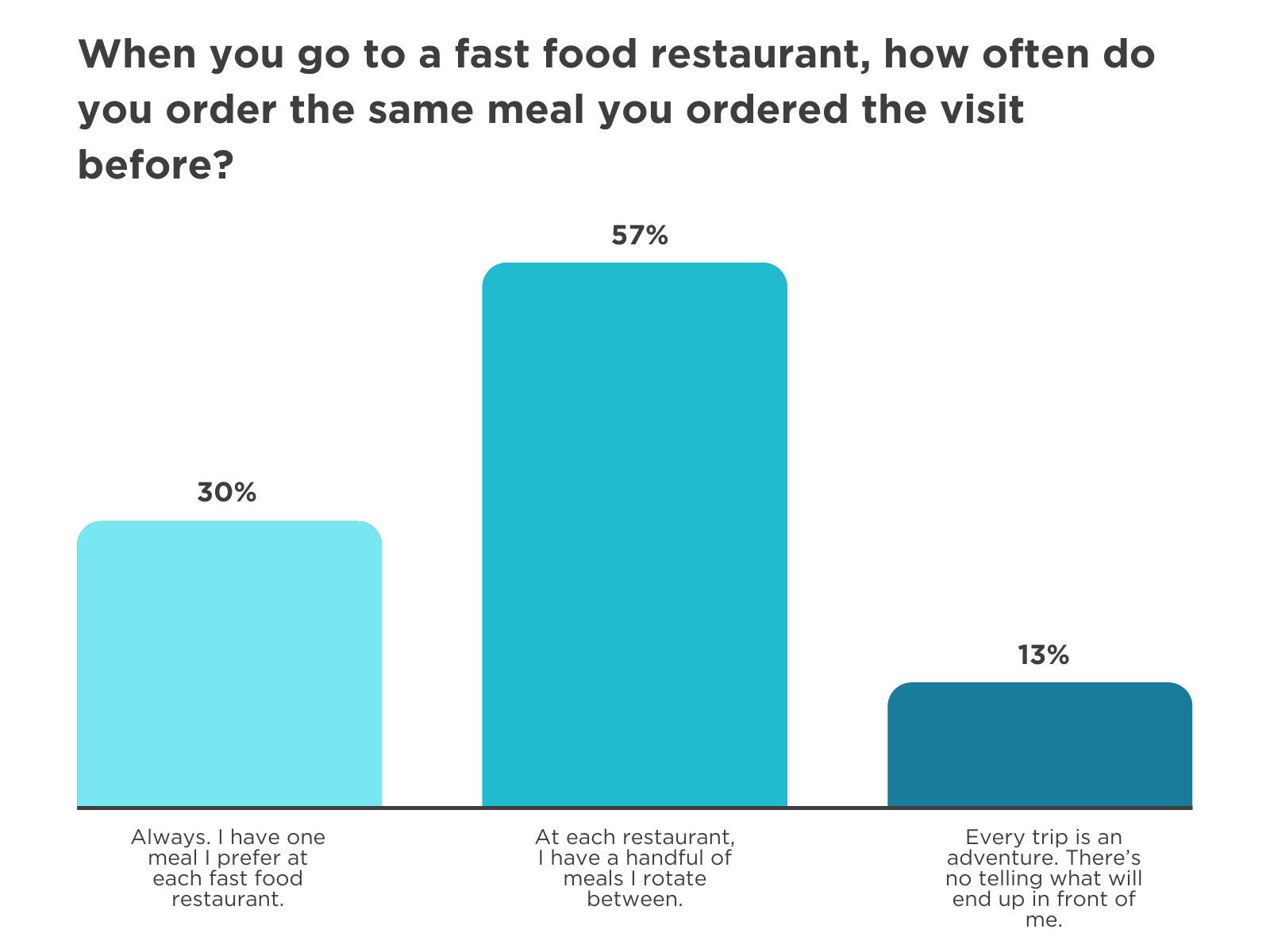
In addition to remaining devoted to our go-to menu, the majority of us stick with a favorite restaurant — and we have for a long time.
- 66% of people said they either have a favorite restaurant they stick with or will occasionally try others.
- 35% found their favorite restaurant more than 5 years ago.
- 30% have had the same favorite restaurant since childhood.
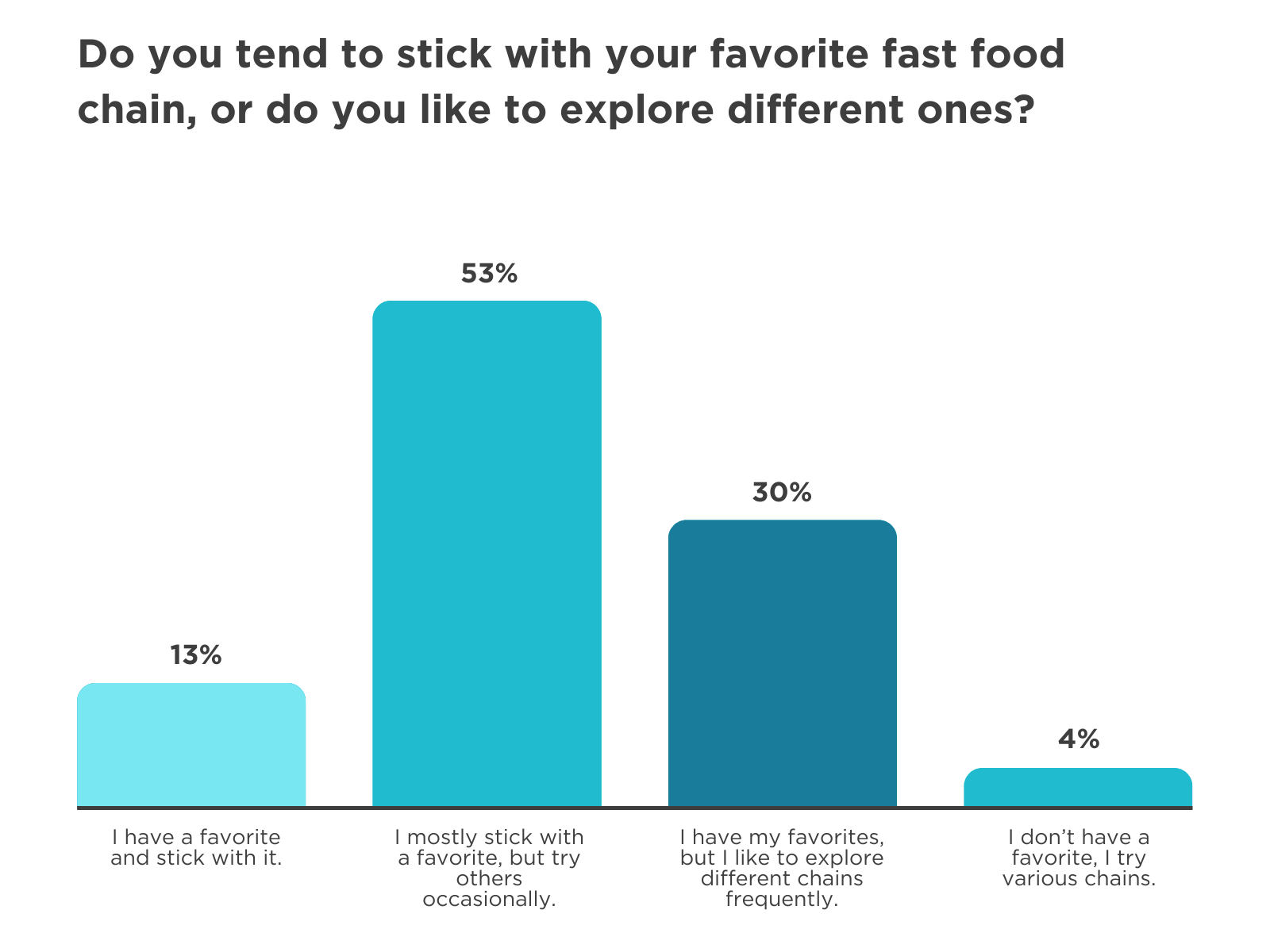
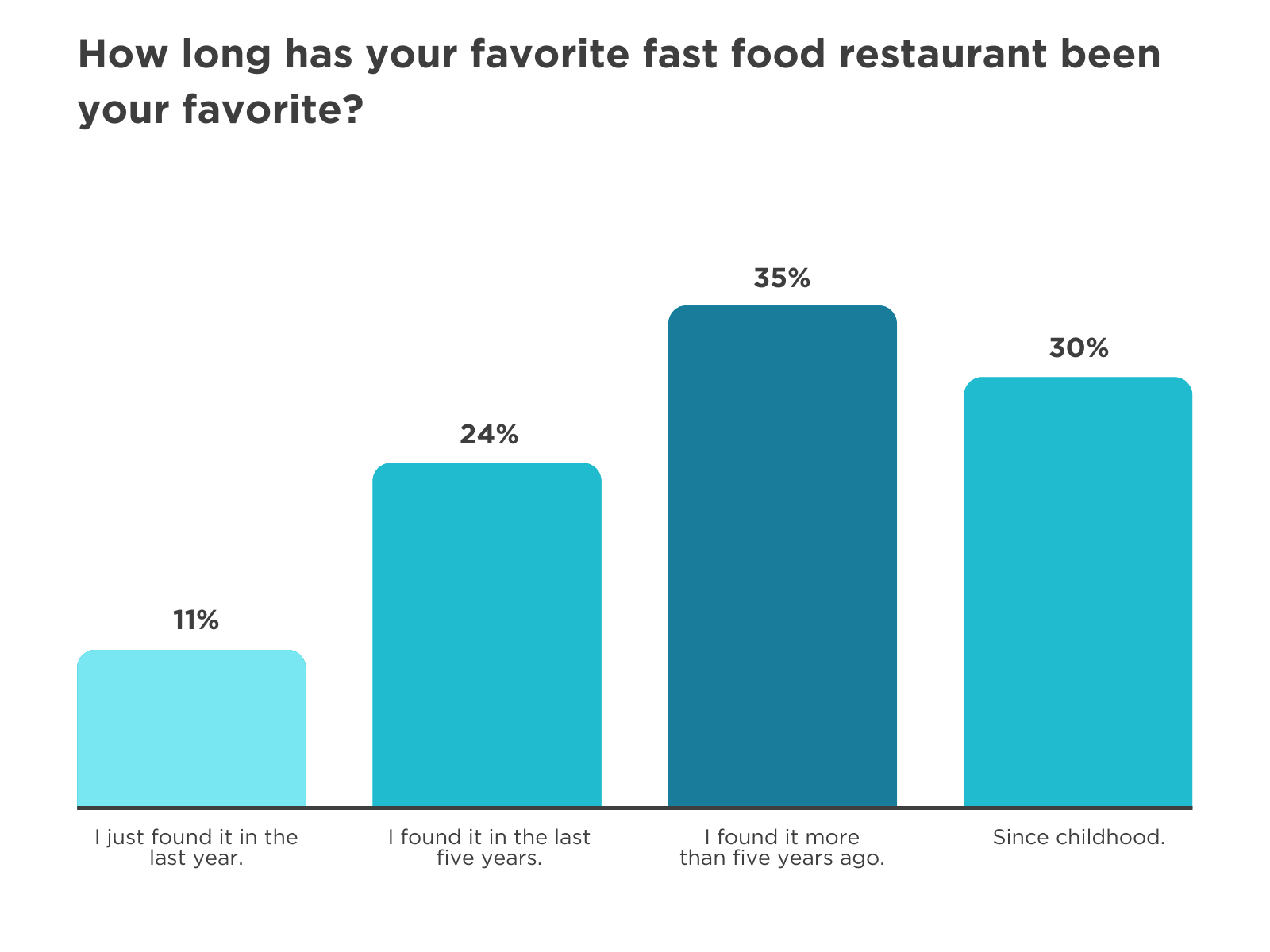
Over half of Americans surveyed (52%) said they most frequently order through the drive-thru.
Drive-thrus have been a staple of the American fast-food landscape for decades, creating a well-established habit and routine for many. People are more likely to opt for what they are familiar with, and the drive-thru has a long-standing tradition in American dining culture – it continues to enjoy popularity over and above ordering apps.
- Just under a quarter order through an app
- 15% order inside from the counter the most often
- 3% said they order inside but at a kiosk
- 11% said where they place their order varies
Old habits die hard, but certain things inspire us to step outside our comfort zones.
When it comes to shifting ordering behavior, tasty imagery and exclusive offers make a significant impact.
- 51% say that great imagery will cause them to linger a little longer on the menu
- 35% say detailed item descriptions are what get their attention
- 86% of people said a limited-time offer or promotion will at least, sometimes, affect their order. Nearly 40% said that these offers often have an impact on what they decide to order.
Limited-time offers or promotions influence order choices to a notable degree, with half of respondents saying that these marketing strategies “sometimes” entice them to try new menu items, and over a quarter saying that these strategies “often” inspire them to branch out from their usual ordering habits. When offers are tied to seasonal specials, the stats jump enormously: nearly all respondents said that these types of offerings will incite them to try something new (or to visit a restaurant again).
- Over 90% of us say that a seasonal special will at least get us to consider revisiting a restaurant.
…but good old-fashioned word-of-mouth helps, too.
Across all age groups, a full quarter of respondents said that hearing about a new menu item through word-of-mouth is enough to get them to try it. These numbers shift slightly when broken down by age groups:
- Ages 18 - 24: 24%
- Ages 25 - 34: 20%
- Ages 35 - 44: 25%
- Ages 45 - 54: 27%
- Ages 54+: 28%
 Younger respondents expressed a preference for social media platforms as the means through which they learn about new menu items and promotions.
Younger respondents expressed a preference for social media platforms as the means through which they learn about new menu items and promotions.
There’s a social aspect to getting people to try new things. For younger people, that’s social media.
- 37% of respondents 18 to 24 said social media is most influential in getting them to try something new on a menu.
- Millennials also showed a taste for social media, with a full quarter responding that they prefer it over other means of influence, such as in-store signage or word-of-mouth.
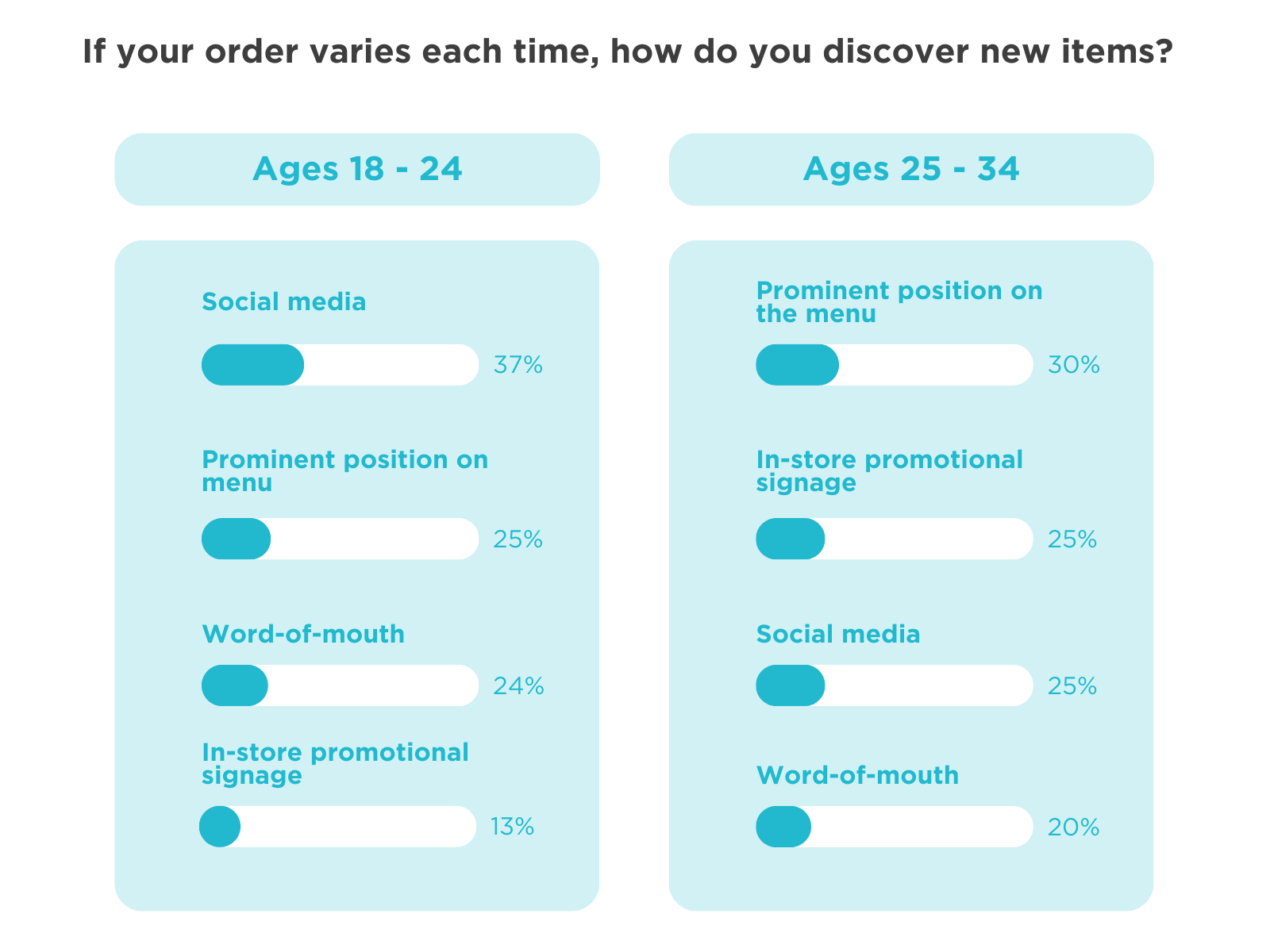
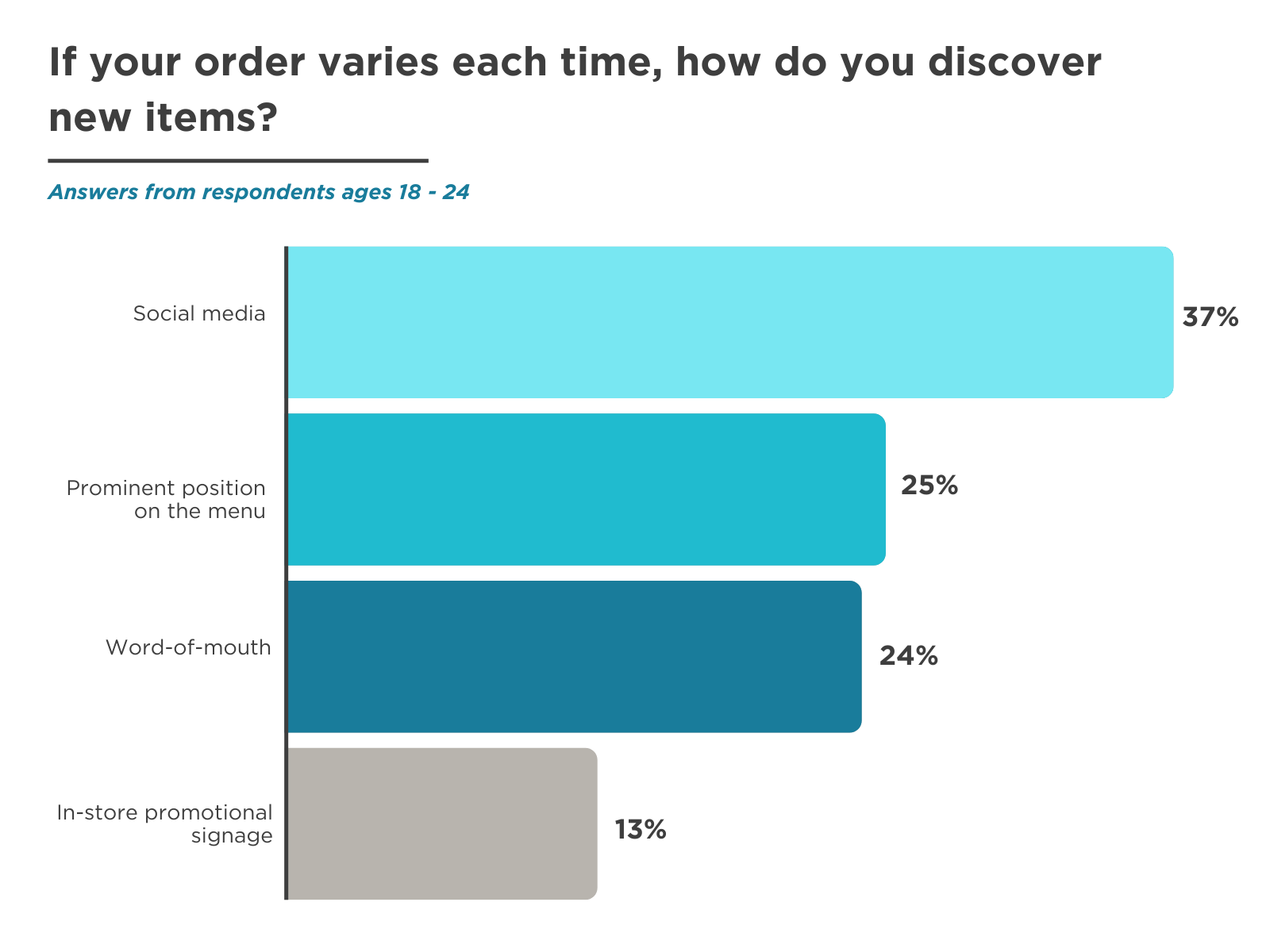
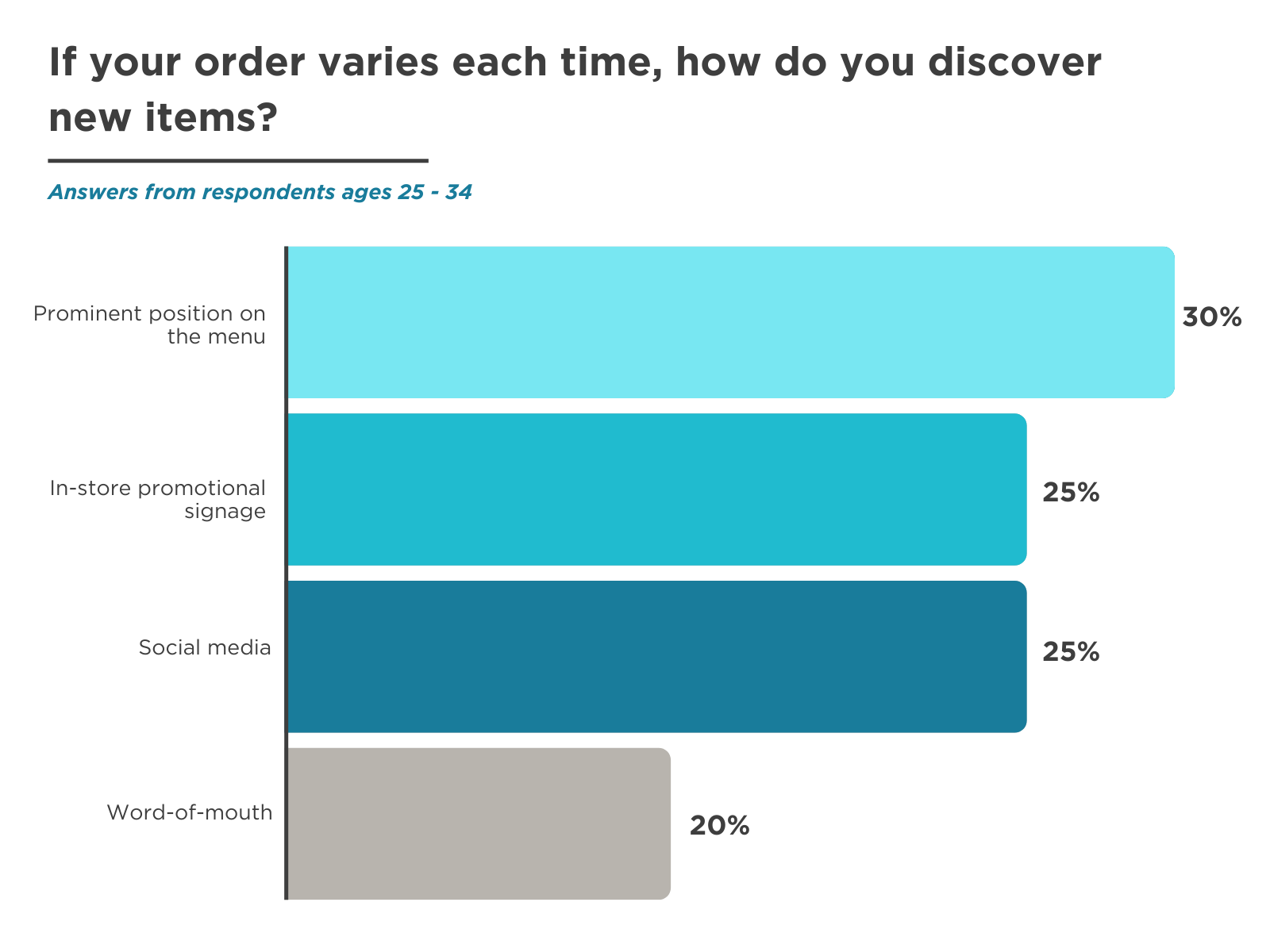
“The American appetite is shaped by a unique demand for convenience, comfort, and predictability,” said Beth Warren, Creative Realities’ senior vice president of marketing. “Quick-service restaurants and drive-thrus play an integral role in our daily lives. Despite most of us being extremely online the majority of the time, the physical experience of going out and getting a fast, hot meal remains both a novelty and a staple for American diners. Restaurants are wise to honor the habits and preferences of diners, but it’s smart business to trust that people are open to trying something new if it’s presented in a way that appeals to them.”
Broadly, the best way to get someone to vary their standard order is through in-store promotional signage, as compared to social media and word-of-mouth.
The presence of physical signage within the dining environment creates a direct connection between the customer and the product, enhancing its perceived authenticity and reliability. The survey showed us that in-store promotional signage continues to enjoy strong influence due to its tangible and immediate nature.
Although younger diners place a premium on social media as an influencing platform, all other categories surveyed reported a higher incidence of being influenced by in-store signage than by other marketing methods.
- Ages 18 - 24: 13%
- Ages 25 - 34: 24%
- Ages 35 - 44: 37%
- Ages 45 - 54: 36%
- Ages 54+: 41%
Menus matter: the layout, imagery, placement, and descriptions of items can make or break ordering behaviors
Along with the social elements that influence our ordering behaviors, the visual experience of in-store signage and drive-thru menus has a big impact on what we choose to chow down on.
- More than half of all respondents reported that tantalizing imagery in the store and on the menu is a catalyst in trying a new item.

When asked about the specific elements of menu design that most impact their ordering choices, limited-time offers or promotions were important to a quarter of respondents, and 15% said that descriptive item names mattered most.
Americans have preferences and opinions regarding how the experience of ordering from a fast food menu could be improved across numerous broad categories.
The voice of the consumer is instrumental in shaping the future of fast food, encouraging the industry to continually evolve and meet the evolving expectations of its diverse customer base. From the speed and accuracy of service to the variety and nutritional value of menu options, American diners are vocal about their desires for an enhanced fast food experience.
Menu Presentation and Layout:
- Clear descriptions and images for all items.
- Consistent pricing and transparent information.
- Items categorized and organized logically.
- Improved organization and better layout of the menu.
Menu Information and Transparency:
- Clear allergen information and nutritional details.
- Transparency about ingredients and preparation.
- Accurate descriptions and information about menu items.
- Introduction of new products and seasonal items.
Order Accuracy and Efficiency:
- Accurate orders and attention to details.
- Faster service and less waiting time.
- Customization options without additional cost.
- Better communication between customers and staff.
Quality and Availability:
- Better quality ingredients and fresher food.
- More availability of items and avoiding out-of-stock situations.
- More consistent and reliable service.
- Clear indication of what is available and what's out of stock.
Customization and Options:
- More customization options for orders.
- Healthier and more vegetarian/vegan choices.
- More variety and flexibility in menu items.
Pricing and Value:
- Lower prices and better value for meals.
- More affordable options and discounts.
- More deals, promotions, and specials.
Technology and Convenience:
- Improved mobile payment and contactless options.
- Faster and accurate order-taking technology.
- Digital menus and online ordering.
Customer Service and Staff Interaction:
- More attentive and friendly staff.
- Clearer communication and attention from workers.
- Improved customer service and professionalism.
Fast Food Experience:
- Less rushed feeling in the drive-thru.
- More efficient service and shorter lines.
- Consistency in experience across locations.
“A well-designed menu in the quick-service restaurant industry holds unparalleled power to influence diner behaviors,” states Warren. “The strategic use of digital signage in crafting visually appealing, informative, and dynamic menus can guide customers towards specific choices, enhance order efficiency, and boost sales. In a world where time is of the essence and options abound, QSRs are poised to maintain a significant role in the American approach to dining and convenience.”
Share this
You May Also Like
These Related Stories
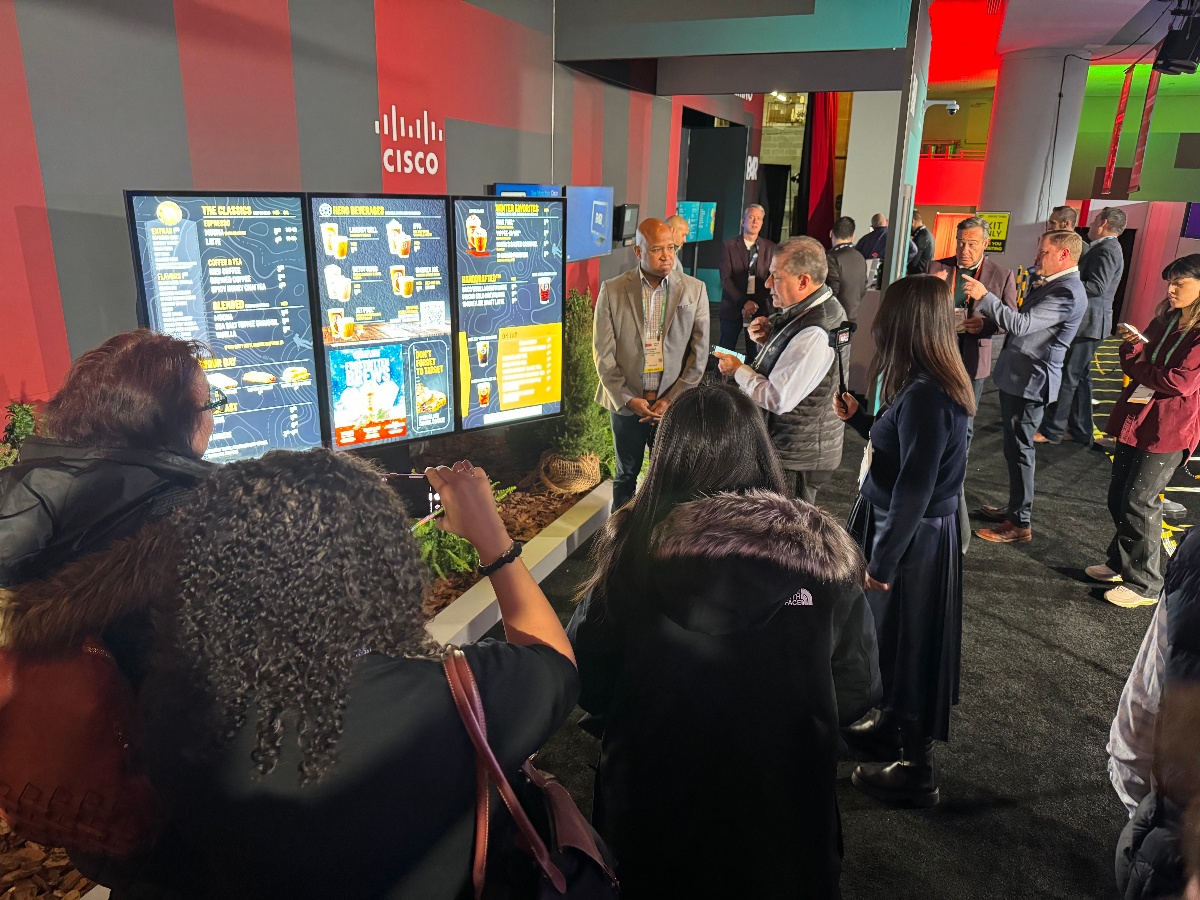
Tech Matters: NRF Big Show and the outtakes for Retail and Foodservice Innovation
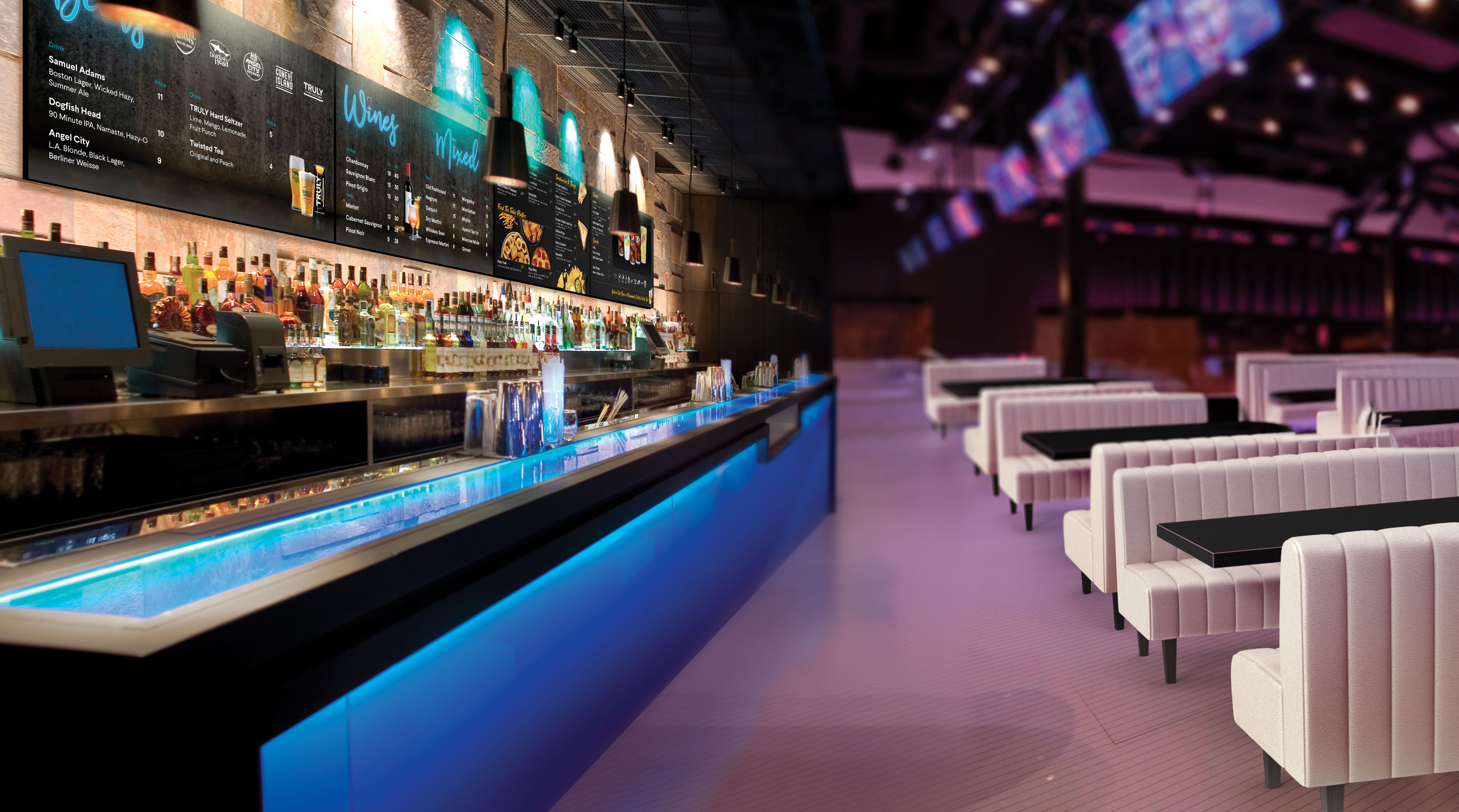
Menu Magic: Unleashing the Power of Data for Dynamic Content
